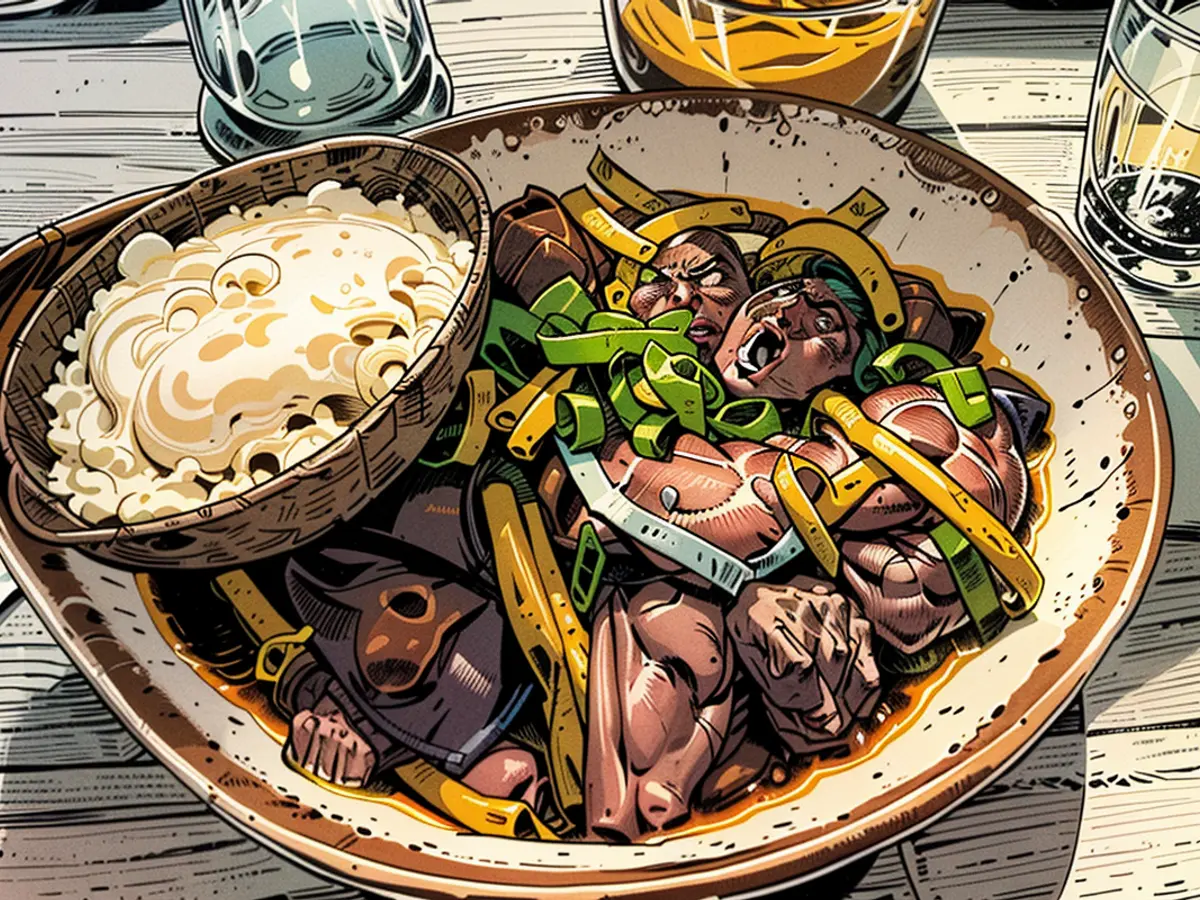Chinese-fusion cuisine is a hidden gem in French Polynesia, offering delicious dishes.
Despite being right next to the largest commercial port, airport, and cruise ship terminal, the water in this area is pristine and brimming with colorful coral and diverse sea creatures.
My guide is searching through the coral reefs for possible dinner options, but I'm hoping we come across some tuna, mackerel, or parrotfish so I can whip up a Chinese variation of French Polynesia's national dish, poisson cru à la chinoise (lime-marinated raw fish with coconut milk).
Both versions of the national dish are popular and tasty, but the Chinese take on this French Polynesian staple begs an interesting question: How did Chinese cuisine become a favorite in this remote French territory?
Starting a new life, thousands of miles from home
Historical records suggest that the first group of Chinese immigrants, primarily from the Hakka and Punti ethnicities, arrived in French Polynesia in 1865.
They were brought from China's Guangdong province to work on a cotton plantation in Atimaono, situated on Tahiti's south side. However, after the plantation owner passed away in 1873 and the cotton company went bankrupt just one year later, many of the Chinese workers had to remain in French Polynesia to begin new lives.
With limited financial resources and being over 11,000 kilometers from home, some of these immigrants continued working the land on the defunct plantation while others opened small businesses, including shops and eateries, throughout the archipelago.
The Chinese population has since grown to become a significant part of the business sector in French Polynesia and now makes up more than 10% of the overseas territory's population.
Faced with limited ingredients, Chinese cooks initially had to adapt to what they could find in French Polynesia. They started incorporating more fresh seafood, fruits like coconut and breadfruit, and staples like taro into their dishes. Soy and oyster sauces, which were necessary for more complex Chinese cooking, would only become more readily available after later waves of immigration from China in the early to mid-1900s, as stated in a Journal of Pacific History article.
With time, this gradual process of culinary evolution also allowed the local Tahitian taste buds to adjust to more robust flavors. Before the Chinese arrived, Tahitian cuisine was quite simple, focusing primarily on salt, pepper, lime, onions, and coconut milk for seasoning.
It's challenging to imagine what the initial blend of Chinese-Tahitian food might have tasted like or looked like with the plentiful Chinese ingredients available in stores today. Fortunately, one fragment of early Chinese-Tahitian cooking has stood the test of time.
Ma'a Tinito, which translates to "Chinese food" in Tahitian, is also the moniker given to a dish that's considered one of this region's earliest Chinese culinary creations.
The Sinitong Association, which oversees the local Chinese cultural associations of French Polynesia, attributes this dish's origin to a Chinese kitchen assistant in the Atimaono district. Desperate for food to satiate the famished plantation workers, he combined red beans, salted pork, bok choy (Chinese cabbage), and long beans to make a hearty and filling meal.

Fascinated by the local’s curiosity, the workers revealed the name of their meal to be Ma'a Tinito. It quickly gained popularity, thanks to its simplicity, affordability, and irresistible flavor.
Preserving culture through food
For a deeper immersion into the tastes and tradition of Chinese-Tahitian cuisine, book a food tour.
"Chinese food is all about family and friends," notes Orama Mollimard, the founder of the local food tour and travel company, Tahiti With Me. "It's meant to be shared and enjoyed by everyone at the table."
Orama spent over a year as a food tour guide before launching her own company in 2024 to share her favorite eats with travelers from around the globe.
Her Papeete food tour showcases Chinese-Tahitian snacks as a nod to her mixed Chinese-Tahitian heritage.
Guests can savor her picks, like steamed chicken rice balls, Chinese-style fish beignets, and plum-powdered mangoes.
When sampling a version of poisson cru à la chinoise, those familiar with Chinese raw fish dishes like yúshēng (meaning "raw fish") may draw some similarities between the two.
Yušēng, nestled in the annals of Chinese culinary history, is a dish with raw fish slices accompanied by a savory-sour-spicy sauce.
This delicacy has been a staple in China for centuries and has spread to far-flung regions, thanks to the Chinese diaspora.
"Chinese food is not just about food, it's about passing on our cultural identity and values," says Orama. "It's like taking a treasured piece of our history and sharing it with everyone who comes to our island."
With its vibrant flavors and deep-rooted heritage, Chinese-Tahitian cuisine provides a unique culinary adventure that leaves you entertained, satiated, and inspired to learn more about this rich, interwoven history.

Imagine Chinese immigrants in the late 1800s or early 1900s experimenting with various combinations of flavors and fish, which eventually led them to create a sweet, sour, and savory Chinese-inspired version of "poisson cru." This delectable dish consists of tuna, julienned carrots and turnips, cucumber, onions, garlic, and ginger, mixed with a beautiful dressing of lemon or lime juice, sugar, salt, pepper, sunflower oil, and rice vinegar - a simple yet scrumptious manifestation of Chinese-Tahitian fusion.
Though not all "poisson cru à la chinoise" recipes include sugar, the collective sweet tooth of French Polynesians makes its absence unthinkable. "Our cooks make the dishes slightly sweeter than they would be normally to appeal to local tastes," says Karl Chung-Tan, the second-generation owner of the Restaurant Golden Lake on the island of Mo'orea.
French Polynesia's chefs are not attempting to simply mirror their counterparts in China; by embracing local ingredients and tastes, as well as traditional Chinese techniques and flavors, they are able to create a genuinely unique and innovative synthesis. Globalization has made it easier to access once hard-to-find ingredients, and while authenticity has its allure, the evolution of Chinese-Tahitian fusion in French Polynesia tells a fascinating culinary story and allows visitors to experience it first-hand.
Tahiti
Restaurant Le Dahlia (Arue)
It was no surprise that my introduction to Chinese-Tahitian cuisine came from Restaurant Le Dahlia. Opened in 1972, it's the most enduring Chinese restaurant in Tahiti. Their roasted suckling pig with coconut milk is one of the best you'll ever taste.
Their steamed black bean parrotfish is also a must-try, but you'll need to call a few days ahead to order it.
Chez Mei (Papeete)
I'm not sure how many times you need to consume "poisson cru" to be a connoisseur, but of the six or seven times I enjoyed the dish during my most recent trip, Chez Mei's version stood out as the finest.
Papeete Sunday Market
Papeete's Sunday Market is the epicenter of French Polynesia's capital city. There, you can find a wide variety of goods, including wild-caught whole tuna, locally grown produce, fresh pastries, "poisson cru" by the pound, and even pearls and souvenirs.
The market is most famous for its impressive assortment of Chinese dim sum offerings. Each item has local names in Tahitian, French, Hakka, or Cantonese, so brush up on your lingual skills and enjoy some snacks!

- Chao pao (steamed stuffed buns)
- Nems (spring rolls)
- Bouchons/Siu Mai (steamed dumplings with pork, shrimp, or chicken)
- Samoussas (fried wontons)
- Lopepan (white glutinous rice dumplings, filled with turnip, chicken, and pepper)
- Founpan (red glutinous rice dumplings, filled with brown sugar and crushed peanuts)
The market opens around 4 a.m., and tourists are advised to arrive early. When I got there at 4:15 a.m., there was already a 20-30 person line for one vendor's famous Pua'a Roti (Cantonese-style barbecue roast pork).
Mo'orea
Restaurant Golden Lake (Temae)
The famous family-style portion of Ma'a Tinito can be prepared on request at Golden Lake. The signature dish features a rich, sweet, and salty brown sauce, tender pieces of pork, and other ingredients - such as beans, macaroni, Chinese cabbage, taro, or rice noodles - that the chef decides to include.
Traditionally, the dish was served with banana; today, locals often enjoy it with rice or bread.
Nestled in Vaitape, the primary city of Bora Bora, visitors will likely pass through it during their travels to or from a jet ski tour, a shark and ray cruise, or while changing between various resorts. This makes it an ideal spot for grabbing a bite to eat while on their way to their next destination.
The shrimp-stuffed fish served at this location was incredibly satisfying.
Resorts
At some of the renowned resorts in Bora Bora, the head chefs and their teams work hard to innovate and create delicious Chinese-Tahitian fusion dishes.
During my visit to three different resorts, I found that they all had a genuine eagerness to create new and exciting menu items for their guests.
Bamboo (St. Regis Bora Bora)

One of the standout dishes at Bamboo, the restaurant at St. Regis Bora Bora, is their caramelized pork stir fry. This dish features tender, slightly fatty pieces of pork that are beautifully crisped, and the addition of purple and green cabbage, onions, and carrots makes it visually enticing.
The portions are modest but ample enough to leave room for dessert. The Cocoriander is a must-try if you enjoy coriander. This delightful treat features a chocolate coconut shell containing homemade coconut ice cream, which can be combined with as much or as little coriander cream as you desire.
Because coriander is not uncommon in Chinese cuisine, its inclusion in this dish illustrates the restaurant's commitment to Chinese-Tahitian fusion.
Banyan (Conrad Bora Bora)
This stylish Chinese restaurant, Banyan, showcases a local take on a classic Cantonese dish. The handcrafted Siu Mai (steamed pork and shrimp dumplings) remind me of those offered at the bustling Sunday Market in Papeete.
You can enjoy them as they are, but feel free to ask the server for some vinegar or chili paste if you prefer to eat dumplings as they often are in China.
The fish and shellfish at Banyan are all locally sourced, including their signature wok-fried spiny lobster.
The dishes are served in family-style portions, so you can expect a generous amount of lobster meat, coated in a rich and delicately flavored homemade XO sauce - a famous Hong Kong condiment.
Vaimiti (Four Seasons Bora Bora)
Set against the breathtaking backdrop of tranquil cyan waters and pristine white sands, Vaimiti offers stunning panoramic views of Mount Otemanu and what could be the world's most stunning beach.
One of the most popular dishes on the menu here, which has been on the menu for nearly two years, is the Hunan-style Mahi Mahi. The "Hunan-style" label suggests a fiery heat, yet this dish has been adjusted to better cater to a global audience with a slightly sweeter chili flavor.

Read also:
- Fear of escalation in the Middle East: US Secretary of State Blinken travels to the region again
- Government circles: US Secretary of State Blinken to travel to Middle East again
- Bridging days 2024: How you can double your vacation this year
- Germany has wanderlust: how tour operators and airlines are looking ahead to the next travel year








